Nissan FRONTIER 2023 Intelligent Cruise Control
Intelligent Cruise Control (ICC) in the 2023 Nissan Frontier is a big step forward in technology that makes driving on the highway and over long distances easier and safer. This cutting-edge driving assistance system uses radar or camera sensors to carefully watch the flow of traffic ahead. It then adjusts the vehicle’s speed to stay at a safe distance behind the vehicle in front of it. Because ICC can adapt to different road conditions, including stop-and-go traffic in some models, it is an important feature for keeping drivers from getting tired or stressed out on long trips. The 2023 Nissan Frontier’s Intelligent Cruise Control is a key part of the evolution of modern driving, making driving on the open road more relaxed and safe. It lets drivers set their own following distances and is often built into a larger suite of advanced safety features.
2023 Nissan Frontier Specs, Price, Features and Mileage (Brochure)
Intelligent Cruise Control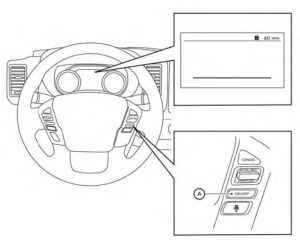
WARNING
Failure to follow the warnings and instructions for proper use of the ICC system could result in serious injury or death.
- The ICC system is only an aid to assist the driver and is not a collision warning or avoidance device. It is the driver’s responsibility to stay alert, drive safely, and be in control of the vehicle at all times.
- Always observe posted speed limits and do not set the speed over them.
- Always drive carefully and attentively when using the ICC system. Read and understand the Owner’s Manual thoroughly before using the ICC system. To avoid serious injury or death, do not rely on the system to prevent accidents or to control the vehicle’s speed in emergency situations. Do not use the ICC system except in appropriate road and traffic conditions.
- In the conventional (fixed speed) cruise control mode, a warning chime will not sound to warn you if you are too close to the vehicle ahead. Pay special attention to the distance between your vehicle and the vehicle ahead of you or a collision could occur.
The ICC system maintains a selected distance from the vehicle in front of you within the speed range of 0 to 90 mph (0 to 144 km/h) up to the set speed. The set speed can be selected by the driver between 20 to 90 mph (30 to 144 km/h). The vehicle travels at a set speed when the road ahead is clear.
The ICC system can be set to one of two cruise control modes:
- Vehicle-to-vehicle distance control mode: For maintaining a selected distance between your vehicle and the vehicle in front of you up to the preset speed
- Conventional (fixed speed) cruise control mode: For cruising at a preset speed Push the ICC switch OA to choose the cruise control mode between the vehicle-to-vehicle distance control mode and the conventional (fixed speed) cruise control mode.
Once a control mode is activated, it cannot be changed to the other cruise control mode. To change the mode, push the ICC switch OA once to turn the system off. Then push the ICC switch OA again to turn the system back on and select the desired cruise control mode. Always confirm the setting in the ICC system display.
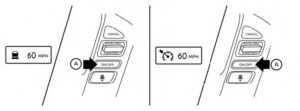
HOW TO SELECT THE CRUISE CONTROL MODE
- Selecting the vehicle-to-vehicle distance control mode:
To choose the vehicle-to-vehicle distance control mode, quickly push and release the ICC switch OA . - Selecting the conventional (fixed speed) cruise control mode: To choose the conventional (fixed speed) cruise control mode, push and hold the ICC switch OA for longer than approximately 1.5 seconds.
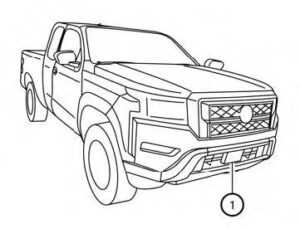
VEHICLE-TO-VEHICLE DISTANCE CONTROL MODE
In the vehicle-to-vehicle distance control mode, the ICC system automatically maintains a selected distance from the vehicle traveling in front of you according to that vehicle’s speed (up to the set speed), or at the set speed when the road ahead is clear. The ICC system is intended to enhance the operation of the vehicle when following a vehicle traveling in the same lane and direction. If the radar sensor 1O detects a slower-moving vehicle ahead, the system will reduce the vehicle speed so that your vehicle follows the vehicle in front at the selected distance. The system automatically controls the throttle and applies the brakes (up to approximately 40% of vehicle braking power) if necessary. The detection range of the sensor is approximately 650 ft (200 m) ahead. 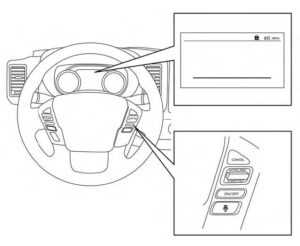
VEHICLE-TO-VEHICLE DISTANCE CONTROL MODE OPERATION
The vehicle-to-vehicle distance control mode is designed to maintain a selected distance from the vehicle in front of you and can reduce the speed to match a slower vehicle ahead. The system will decelerate the vehicle as necessary and if the vehicle ahead comes to a stop, the vehicle decelerates to a standstill. However, the ICC system can only apply up to 40% of the vehicle’s total braking power. This system should only be used when traffic conditions allow vehicle speeds to remain fairly constant or when vehicle speeds change gradually. If a vehicle moves into the traveling lane ahead or if a vehicle traveling ahead rapidly decelerates, the distance between vehicles may become closer because the ICC system cannot decelerate the vehicle quickly enough. If this occurs, the ICC system will sound a warning chime and blink the system display to notify the driver to take necessary action.
The system will cancel and a warning chime will sound if the speed is below approximately 15 mph (25 km/h) and a vehicle is not detected ahead. The system will also disengage when the vehicle goes above the maximum set speed.
For additional information, see “Approach warning.
The following items are controlled in the vehicle-to-vehicle distance control mode: running”
- When there are no vehicles traveling ahead, the vehicle-to-vehicle distance control mode maintains the speed set by the driver. The set speed range is between approximately 20 and 90 mph (30 and 144 km/h).
- When there is a vehicle traveling ahead, the vehicle-to-vehicle distance control mode adjusts the speed to maintain the distance, selected by the driver, from the vehicle ahead. If the vehicle ahead comes to a stop, the vehicle decelerates to a standstill within the limitations of the system. The system will cancel once it judges a standstill with a warning chime.
- When the vehicle traveling ahead has moved out from its lane of travel, the vehicle-to-vehicle distance control mode accelerates and maintains vehicle speed up to the set speed.
The ICC system does not control vehicle speed or warn you when you approach stationary and slow-moving vehicles. You must pay attention to vehicle operation to maintain proper distance from vehicles ahead when approaching toll gates or traffic congestion.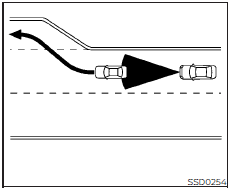
When driving on the freeway at a set speed and approaching a slower traveling vehicle ahead, the ICC system will adjust the speed to maintain the distance, selected by the driver, from the vehicle ahead. If the vehicle ahead changes lanes or exits the freeway, the ICC system will accelerate and maintain the speed up to the set speed. Pay attention to the driving operation to maintain control of the vehicle as it accelerates to the set speed. The vehicle may not maintain the set speed on winding or hilly roads. If this occurs, you will have to manually control the vehicle’s speed. Normally when controlling the distance to a vehicle ahead, this system automatically accelerates or decelerates your vehicle according to the speed of the vehicle ahead. Depress the accelerator to properly accelerate your vehicle when acceleration is required for a lane change. Depress the brake pedal when deceleration is required to maintain a safe distance from the vehicle ahead due to its sudden braking or if a vehicle cuts in. Always stay alert when using the ICC system.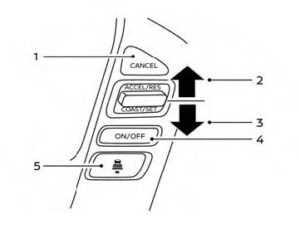
VEHICLE-TO-VEHICLE DISTANCE CONTROL MODE SWITCHES
The system is operated by the ICC switch and four control switches, all mounted on the steering wheel.
- CANCEL switch:
Deactivates the system without erasing the set speed. - ACCEL/RES switch:
Resumes set speed or increase speed incrementally. - COAST/SET switch:
Sets desired cruise speed or reduces speed incrementally. - ICC switch:
Master switch to activate the system. - DISTANCE switch:
- switch:
Changes the vehicle’s following distance:- Long
- Middle
- Short
- switch:

Vehicle-to-vehicle distance control mode display and indicators
The display is located between the speedometer and the tachometer.
- This indicator indicates the ICC system status depending on a color:
- ICC system ON indicator (gray): Indicates that the ICC switch is on.
- ICC system SET indicator (green): Indicates that the cruising speed is set.
- ICC system warning (yellow): Indicates that there is a malfunction in the ICC system.
- Set vehicle speed indicator:
Indicates the set vehicle speed.
For Canadian models, the speed is displayed in km/h. - Vehicle ahead detection indicator: Indicates whether it detects a vehicle in front of you.
- Set distance indicator:
Displays the selected distance between vehicles set with the distance switch.
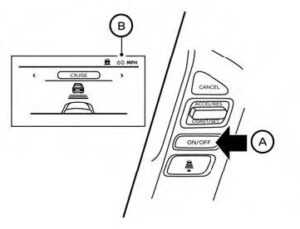 Operating vehicle-to-vehicle distance control mode
Operating vehicle-to-vehicle distance control mode
To turn on the cruise control, quickly push and release the ICC switch OA. The ICC system ON indicator (gray), set distance indicator, and set vehicle speed indicator OB to come on in a standby state for setting.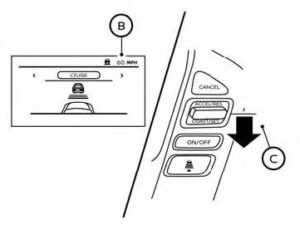
To set cruising speed, accelerate your vehicle to the desired speed, push the COAST/SET switch OC, and release it. The ICC system set indicator (green), the vehicle ahead detection indicator, the set distance indicator, and the set vehicle speed indicator OB will come on. Take your foot off the accelerator pedal. Your vehicle will maintain the set speed.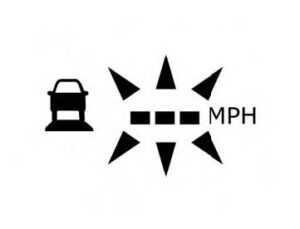
When the COAST/SET switch is pushed under the following conditions, the system cannot be set and the ICC indicators will blink for approximately 2 seconds:
- When traveling below 20 mph (30 km/h) and a vehicle ahead is not detected
- When the shift lever is not in the D (Drive) or Manual mode
- When the parking brake is applied
- When the brakes are operated by the driver
When the COAST/SET switch is pushed under the following conditions, the system cannot be set.
A warning chime will sound and a message will pop up:
- When the VDC system is off (To use the ICC system, turn on the VDC system. Push the ICC switch to turn off the ICC system and reset the ICC switch by pushing the ICC switch again.)
- When VDC is operating
- When a wheel is slipping (To use the ICC system, make sure the wheels are no longer slipping.)
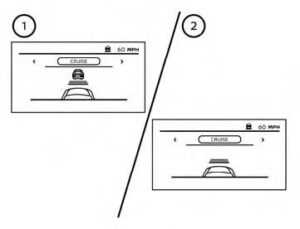
- The system is set to display the vehicle ahead The system is set to display without vehicle ahead The driver sets the desired vehicle speed based on the road conditions. The ICC system maintains the set vehicle speed, similar to standard cruise control, as long as no vehicle is detected in the lane ahead. The ICC system displays the set speed.
Vehicle detected ahead
When a vehicle is detected in the lane ahead, the ICC system decelerates the vehicle by controlling the throttle and applying the brakes to match the speed of a slower vehicle ahead. The system then controls the vehicle’s speed based on the speed of the vehicle ahead to maintain the driver-selected distance.
NOTE:
- The stop lights of the vehicle come on when braking is performed by the ICC system.
- When the brake operates, a noise may be heard. This is not a malfunction.
When a vehicle ahead is detected, the vehicle ahead detection indicator comes on. The ICC system will also display the set speed and selected distance.
The vehicle ahead was not detected
When a vehicle is no longer detected ahead, the ICC system gradually accelerates your vehicle to resume the previously set vehicle speed. The ICC system then maintains the set speed. When a vehicle is no longer detected, the vehicle ahead detection indicator turns off. If a vehicle ahead appears during acceleration to the set vehicle speed or any time the ICC system is in operation, the system controls the distance to that vehicle. When a vehicle is no longer detected under approximately 15 mph (24 km/h), the system will be canceled.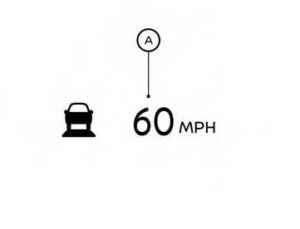
When passing another vehicle, the set
speed indicator OA will flash when the vehicle speed exceeds the set speed. The vehicle detect indicator will turn off when the area ahead of the vehicle is open. When the pedal is released, the vehicle will return to the previously set speed. Even though your vehicle speed is set in the ICC system, you can depress the accelerator pedal when it is necessary to accelerate your vehicle rapidly.
How to change the set vehicle speed
To cancel the preset speed, use one of the following methods:
- Push the CANCEL switch. The set vehicle speed indicator will go out.
- Tap the brake pedal. The set vehicle speed indicator will go out.
- Push the ICC switch to off. The ICC indicators will go out.
To reset at a faster cruising speed, use one of the following methods:
- Depress the accelerator pedal. When the vehicle attains the desired speed, push and release the COAST/SET switch.
- Push and hold the ACCEL/RES switch. The set vehicle speed will increase by approximately 5 mph (5 km/h).
- Push, then quickly release the ACCEL/RES switch. Each time you do this, the set speed will increase by approximately 1 mph (1 km/h).
To reset at a slower cruising speed, use one of the following methods:
- Lightly tap the brake pedal. When the vehicle attains the desired speed, push the COAST/SET switch and release it.
- Push and hold the COAST/SET switch. The set vehicle speed will decrease by approximately 5 mph (5 km/h).
- Push, then quickly release the COAST/SET switch. Each time you do this, the set speed will decrease by approximately 1 mph (1 km/h).
To resume the preset speed, push and release the ACCEL/RES switch. The vehicle will resume the last set cruising speed when the vehicle speed is over 20 mph (32 km/h).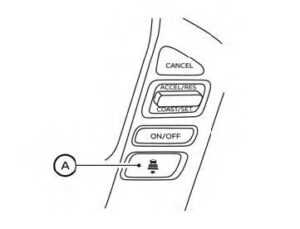
How to change the set distance to the vehicle ahead
The distance to the vehicle ahead can be selected at any time depending on the traffic conditions. Each time the distance switch OA is pushed, the set distance will change to long, middle, short, and back to long again, in that sequence.
Distance Approximate distance at
- 60 mph (100 km/h)[ft (m)]
- 200 (60)
- 150 (45)
- 90 (30)
- Long
- Middle
- Short
- The distance to the vehicle ahead will change according to the vehicle’s speed. The higher the vehicle speed, the longer the distance.
- The distance setting will remain at the current setting even if the engine is restarted.
Approach warning
If your vehicle comes closer to the vehicle ahead due to rapid deceleration of that vehicle or if another vehicle cuts in, the system warns the driver with the chime and ICC system display.
Decelerate by depressing the brake pedal to maintain a safe vehicle distance if:
- The chime sounds.
- The vehicle ahead detection indicator blinks.
The warning chime may not sound in some cases when there is a short distance between vehicles.
Some examples are:
- When the vehicles are traveling at the same speed the distance between vehicles is not changing.
- When the vehicle ahead is traveling faster the distance between vehicles is increasing.
- When a vehicle cuts in near your vehicle. The warning chime will not sound when:
- The vehicle approaches other vehicles that are parked or moving slowly.
- The accelerator pedal is depressed, overriding the system.
NOTE:
The approach warning chime may sound and the system display may blink when the ICC sensor detects objects on the side of the vehicle or on the side of the road. This may cause the ICC system to decelerate or accelerate the vehicle. The ICC sensor may detect these objects when the vehicle is driven on winding roads, narrow roads, or hilly roads, or when entering or exiting a curve. In these cases, you will have to manually control the proper distance ahead of your vehicle. Also, the sensor sensitivity can be affected by vehicle operation (steering maneuver or driving position in the lane) or traffic or vehicle condition (for example, if a vehicle is being driven with some damage).
Automatic cancellation
A chime sounds under the following conditions and the control is automatically canceled:
- When the vehicle ahead is not detected and your vehicle is traveling below the speed of 15 mph (25 km/h)
- When the system judges the vehicle is at a standstill
- When the shift lever is not in the D (Drive) position, Manual mode or L (Low) range.
- When the parking brake system is applied
- When the VDC system is turned off
- When VDC operates
- When distance measurement becomes impaired due to the adhesion of dirt or obstruction to the sensor
- When a wheel slips
- When the radar signal is temporarily interrupted
VEHICLE-TO-VEHICLE DISTANCE CONTROL MODE LIMITATIONS
Listed below are the system limitations for the ICC system. Failure to operate the vehicle in accordance with these system limitations could result in serious injury or death.
- The ICC system is primarily intended for use on straight, dry, open roads with light traffic. It is not advisable to use the ICC system in city traffic or congested areas.
- The ICC system will not adapt automatically to road conditions. This system should be used in evenly flowing traffic. Do not use the system on roads with sharp curves, on icy roads, in heavy rain, or in fog.
- As there is a performance limit to the distance control function, never rely solely on the ICC system. This system does not correct careless, inattentive, or absentminded driving, or overcome poor visibility in rain, fog, or other bad weather. Decelerate the vehicle speed by depressing the brake pedal, depending on the distance to the vehicle ahead and the surrounding circumstances in order to maintain a safe distance between vehicles.
- If the vehicle ahead comes to a stop, the vehicle decelerates to a standstill within the limitations of the system. The system will cancel once it judges that the vehicle has come to a stand-still and sounds a warning chime. To prevent the vehicle from moving, the driver must depress the brake pedal.
- Always pay attention to the operation of the vehicle and be ready to manually control the proper following distance. The ICC system may not be able to maintain the selected distance between vehicles (following distance) or selected vehicle speed under some circumstances.
- The system may not detect the vehicle in front of you in certain road or weather conditions. To avoid accidents, never use the ICC system under the following conditions:
- On roads where the traffic is heavy or there are sharp curves
- On slippery road surfaces such as on ice or snow, etc.
- During bad weather (rain, fog, snow, etc.)
- Wheels or tires other than NISSAN recommended are used.
- When rain, snow, or dirt adheres to the bumper around the distance sensor
- On steep downhill roads (the vehicle may go beyond the set vehicle speed and frequent braking may result in overheating the brakes)
The radar sensor will not detect the following objects:
- Stationary and slow-moving vehicles
- Pedestrians or objects in the roadway
- Oncoming vehicles in the same lane
- Motorcycles traveling offset in the travel lane
The sensor generally detects the signals returned from the vehicle ahead. Therefore, if the sensor cannot detect the reflection from the vehicle ahead, the ICC system may not maintain the selected distance. The following are some conditions in which the sensor cannot properly detect a vehicle ahead and the system may not operate properly:
- When snow or road spray from traveling vehicles reduces the sensor’s detection.
- When your vehicle is towing a trailer, etc.
- When excessively heavy baggage is loaded in the rear seat or cargo area of your vehicle.
The ICC system is designed to automatically check the sensor’s operation within the limitations of the system. When the sensor is covered with dirt or is obstructed, the system will automatically be canceled. If the sensor is covered with ice, a transparent or translucent vinyl bag, etc., the ICC system may not detect them. In these instances, the vehicle-to-vehicle distance control mode may not cancel and may not be able to maintain the selected following distance from the vehicle ahead. Be sure to check and clean the sensor regularly. The detection zone of the radar sensor is limited. A vehicle ahead must be in the detection zone for the vehicle-to-vehicle distance detection mode to maintain the selected distance from the vehicle ahead. A vehicle ahead may move outside of the detection zone due to its position within the same lane of travel. Motorcycles may not be detected in the same lane ahead if they are traveling offset from the centerline of the lane. A vehicle that is entering the lane ahead may not be detected until the vehicle has completely moved into the lane. If this occurs, the ICC system may warn you by blinking the system indicator and sounding the chime. The driver may have to manually control the proper distance away from a vehicle traveling ahead.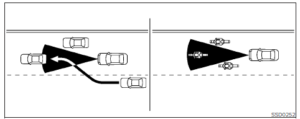

When driving on some roads, such as winding, hilly, curved, narrow roads, or roads that are under construction, the radar sensor may detect vehicles in a different lane, or may temporarily not detect a vehicle traveling ahead. This may cause the radar system to decelerate or accelerate the vehicle. The detection of vehicles may also be affected by vehicle operation (steering maneuver or travelling position in the lane, etc.) or vehicle condition. If this occurs, the ICC system may warn you by blinking the system indicator and sounding the chime unexpectedly. You will have to manually control the proper distance away from the vehicle traveling ahead.
SYSTEM TEMPORARILY UNAVAILABLE
The following are conditions in which the ICC system may be temporarily unavailable. In these instances, the ICC system may not cancel and may not be able to maintain the selected following distance from the vehicle ahead.
Condition A
Under the following conditions, the ICC system is automatically canceled.
A chime will sound and the system will not be able to be set:
- When the VDC system is turned off
- When the VDC operates
- When a vehicle ahead is not detected and your vehicle is traveling below the speed of 15 mph (25 km/h)
- When the system judges the vehicle is at a standstill
- When the shift lever is not in the D (Drive), Manual mode, or L (Low) range
- When the parking brake is applied
- When a wheel slips
- When the radar signal is temporarily interrupted
Action to take
When the conditions listed above are no longer present, turn the system off using the ICC switch. Turn the ICC system back on to use the system.
Condition B
When there is inclement weather (rain, fog, snow, etc.) blocking the front radar sensor, the ICC system will automatically be canceled. The chime will sound and the “For-ward Driving Aids Temporarily Disabled Front Sensor Blocked See Owner’s Manual” warning message will appear in the vehicle information display.
Action to take
When the conditions listed above are no longer present, the warning message will no longer be available in the vehicle information display and the system will operate normally. If the “Forward Driving Aids Temporarily Disabled Front Sensor Blocked See Owner’s Manual” warning message continues to be displayed, have the system checked. It is recommended that you visit a NISSAN dealer for this service.
Condition C
When the radar sensor area of the front bumper/emblem is covered with mud, dirt, snow, ice, etc., or is obstructed, the ICC system will automatically be canceled. The chime will sound and the “Forward Driving Aids Temporarily Disabled Front Sensor Blocked See Owner’s Manual” warning message will appear in the vehicle information display.
Action to take
If the warning message appears, stop the vehicle in a safe place, place the shift lever in the P (Park) position, and turn the engine off. When the radar signal is temporarily interrupted, clean the sensor area of the front bumper/emblem and restart the engine. If the “Forward Driving Aids Temporarily Disabled Front Sensor Blocked See Own-er’s Manual” warning message continues to be displayed, have the system checked. It is recommended that you visit a NISSAN dealer for this service.
Condition D
When driving on roads with limited road structures (for example, long bridges, deserts, snow fields, driving next to long walls), the system may illuminate the system warning light and display the ““Forward Driving Aids Temporarily Disabled Front Sensor Blocked See Owner’s Manual” message.
Action to take
When the above driving conditions no longer exist, turn the system back on.
Condition E
When the ICC system is not operating properly, a chime sounds and the ICC system warning light (orange) will come on.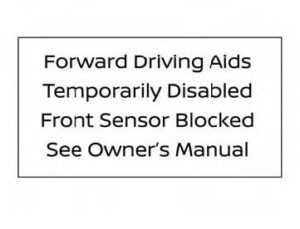
Action to take
If the warning light comes on, park the vehicle in a safe place. Turn the engine off, restart the engine, resume driving, and set the ICC system again. If it is not possible to set the system or the indicator stays on, it may indicate that the system is malfunctioning. Although the vehicle is still drivable under normal conditions, have the vehicle checked? It is recommended that you visit a NISSAN dealer for this service.
NOTE:
If the ICC system is temporarily unavailable, the conventional cruise control mode may still be used.
SYSTEM MAINTENANCE
The sensor for the ICC system 1O is located on the front of the vehicle.
To keep the ICC system operating properly, be sure to observe the following:
- Always keep the sensor area of the front bumper/emblem clean.
- Do not strike or damage the areas around the sensor.
- Do not attach a sticker (including transparent material) or install an accessory near the sensor. This could cause failure or malfunction.
- Do not attach metallic objects near the sensor area (brush guard, etc.). This could cause failure or malfunction.
- Do not alter, remove, or paint the front bumper. Before customizing or restoring the front bumper, it is recommended that you visit a NISSAN dealer.
Radiofrequency statement
FCC Notice
USA
FCC ID: OAYARS4B
This device complies with Part 15 of the FCC Rules with Industry Canada licence-exempt RSS standard(s).
Operation is subject to the following two conditions:
- This device may not cause harmful interference, and
- This device must accept any interference received, including interference that may cause undesired operation.
Radiofrequency radiation exposure Information:
This equipment complies with FCC and IC radiation exposure limits set forth for an uncontrolled environment. This equipment should be installed and operated with a minimum distance of 30 cm between the radiator and your body. This transmitter must not be co-located or operating in conjunction with any other antenna or transmitter.
Operation is subject to the following two conditions:
- This device may not cause harmful interference, and
- This device must accept any interference received, including interference that may cause undesired operation.
Radiofrequency radiation exposure Information:
This equipment complies with FCC and IC radiation exposure limits set forth for an uncontrolled environment. This equipment should be installed and operated with a minimum distance of 30 cm between the radiator and your body. This transmitter must not be co-located or operating in conjunction with any other antenna or transmitter.
FCC Notice
Changes or modifications not expressly approved by the party responsible for compliance could void the user’s authority to operate the equipment.
CONVENTIONAL (fixed speed)
This mode allows driving at a speed between 25 to 90 mph (40 to 144 km/h) without keeping your foot on the accelerator pedal.
WARNING
- In the conventional (fixed speed) cruise control mode, a warning chime does not sound to warn you if you are too close to the vehicle ahead, as neither the presence of the vehicle ahead nor the vehicle-to-vehicle distance is detected.
- Pay special attention to the distance between your vehicle and the vehicle ahead of you or a collision could occur.
- Always confirm the setting in the ICC system display.
- Do not use the conventional (fixed speed) cruise control mode when driving under the following conditions:
- When it is not possible to keep the vehicle at a set speed
- In heavy traffic or in traffic that varies in speed
- On winding or hilly roads
- On slippery roads (rain, snow, ice, etc.)
- In very windy areas
- Doing so could cause a loss of vehicle control and result in an accident.
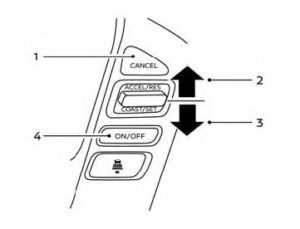
Conventional (fixed speed) cruise control switches
- CANCEL switch:
Deactivates the system without erasing the set speed - ACCEL/RES switch:
Resumes set speed or increase speed incrementally - COAST/SET switch:
Sets desired cruise speed or reduce speed incrementally - ICC switch:
Master switch to activate the system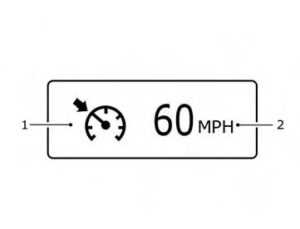
Conventional (fixed speed) cruise control mode display and indicators The display is located in the vehicle information display.
- Cruise indicator:
This indicator indicates the condition of the ICC system depending on a color.- Cruise control ON indicator (gray): Indicates that the ICC switch is on
- Cruise control SET indicator (green): Indicates that the cruising speed is set
- Cruise control warning (yellow): Indicates that there is a malfunction in the ICC system
- Set vehicle speed indicator:
This indicator indicates the set vehicle speed. For Canadian models, the speed is displayed in km/h.
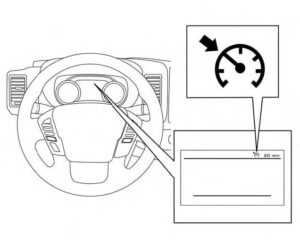
System temporarily disabled
A chime sounds under the following conditions and the control is automatically canceled:
- When the vehicle slows down more than 8 mph (13 km/h) below the set speed
- When the shift lever is not in the D (Drive) or manual shift mode
- When the parking brake is applied
- When the VDC operates (including the traction control system)
- When a wheel slips
When the system is not operating properly, the chime sounds, and the color of the cruise indicator will change to orange.
Action to take
If the color of the cruise indicator changes to orange, stop the vehicle in a safe place and place the shift lever in the P (Park) position. Turn the engine off, restart the engine, resume driving, and then perform the setting again. If it is not possible to set or the indicator stays on, it may indicate that the system is malfunctioning. Although the vehicle is still drivable under normal conditions, have the vehicle checked? It is recommended that you visit a NISSAN dealer for this service.
FAQ
Intelligent Cruise Control (ICC) is an advanced driver assistance system that automatically adjusts the vehicle’s speed to maintain a safe following distance from the vehicle ahead.
It uses radar or camera sensors to monitor traffic conditions and can accelerate or brake to keep the preset following distance.
Yes, you can usually adjust the following distance to your preference, typically through the vehicle’s settings menu.
Some versions of ICC can operate in stop-and-go traffic, automatically bringing the vehicle to a complete stop and resuming when traffic moves.
Yes, you can adjust the cruise control speed using the vehicle’s controls.
Yes, you can usually override it by applying the brakes or using the accelerator pedal.
ICC typically works at a wide range of speeds, from highway speeds to slower urban driving.
Availability may vary by trim level and optional packages.
ICC’s performance may be affected by adverse weather conditions, such as heavy rain, snow, or fog.
Some models may offer collision warnings or autonomous braking if a potential collision is detected.
Yes, ICC is often part of a comprehensive suite of advanced driver assistance systems, including features like lane departure warning and blind-spot monitoring.
ICC is primarily designed for use on straight highways, and its effectiveness on curvy roads may be limited.
The maximum speed at which ICC operates may vary between different vehicle models.
Yes, you can typically resume the previously set cruise control speed after braking by using the resume button.
No, it is not a substitute for attentive driving, and drivers should always remain engaged and ready to take control of the vehicle when necessary.
Useful Link
View Full User Guide: Nissan FRONTIER 2023 User Guide
Download Manuals: https://www.nissanusa.com/owners/ownership/manuals-guides.html
2023 Nissan Frontier Specs, Price, Features and Mileage (Brochure)


